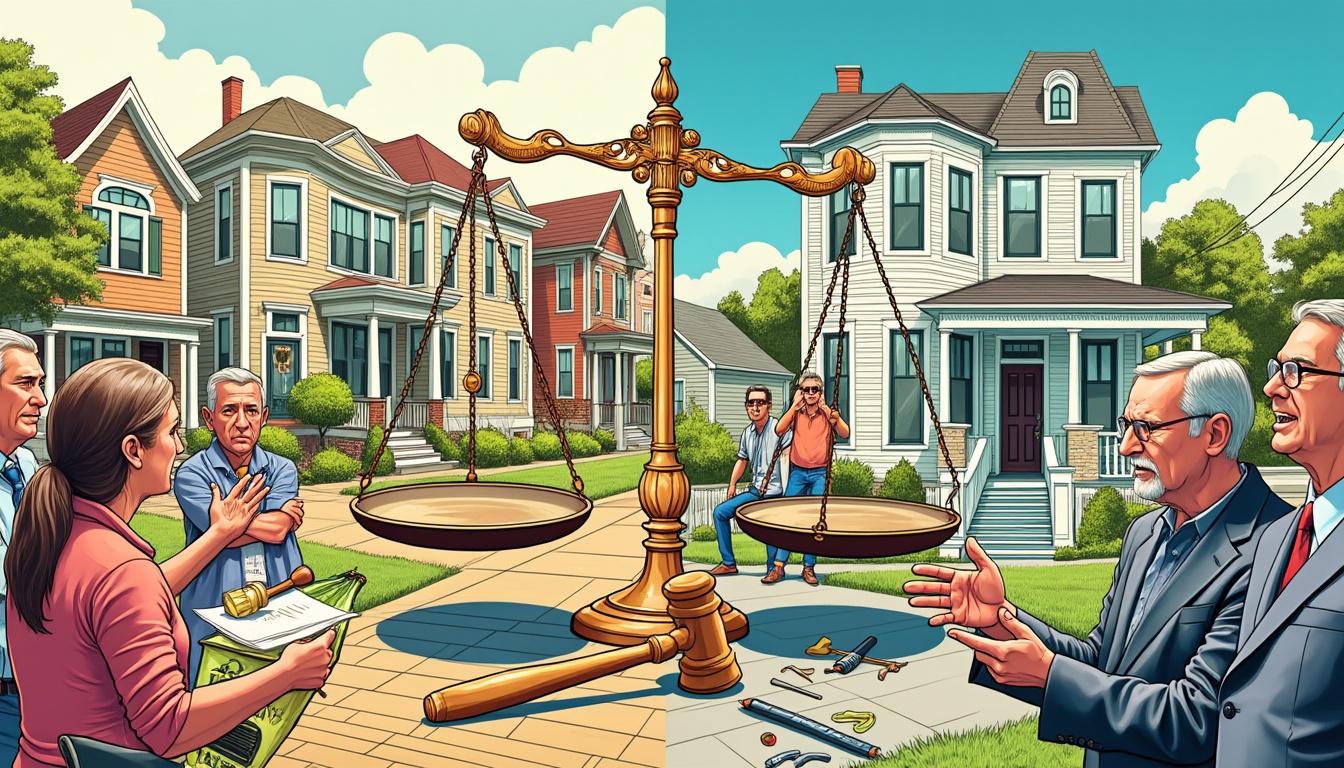In urban landscapes shaped by evolving real estate dynamics, the establishment of historic districts often ignites complex debates between homeowners and preservation authorities. These designated areas, championed by organizations such as the Preservation Society and Heritage Management Group, aim to safeguard architectural and cultural legacies. However, homeowners frequently find themselves at odds with regulations that can restrict property modifications, fueling tensions that reverberate across community, economic, and legal dimensions. This friction challenges stakeholders like Heritage Home Solutions and Classic Property Advisors to navigate a delicate balance between protecting timeless neighborhoods and honoring homeowners’ rights. As cities expand and development pressures intensify, understanding this clash becomes pivotal for sustaining cultural heritage without stalling urban growth.
Historic District Real Estate Regulations: Balancing Preservation and Property Rights
Designation of historic districts imposes specific regulations on property owners. These regulations often focus on exterior modifications to preserve the aesthetic integrity of neighborhoods rich in cultural heritage. For example, many homeowners within Philadelphia’s Washington Square West historic district must seek approval from the Historical Commission before installing new windows, solar panels, or changing door designs. These requirements, championed by preservation groups like the Preservation Society, ensure that changes align with the district’s historic character.
However, these regulations often create friction with property owners and advocate groups such as the Homeowner Advocate Group. Owners argue that the stringent approval process not only delays renovations but also leads to increased costs due to mandates for historically accurate materials. In some cases, younger buildings, which lack historic significance, are grouped under the same strictures as older properties, amplifying frustrations among homeowners.
Understanding this tension involves examining several key factors:
- Preservation Objectives: Maintaining the visual and cultural authenticity of neighborhoods where architectural styles reflect historic eras.
- Property Owner Restrictions: Limitations on the scope and design of renovations, impacting both the exterior appearance and potential property enhancements.
- Economic Implications: Increased renovation costs and potential impacts on property values due to regulatory oversight.
- Urban Development Pressure: Conflicts between historic preservation and demand for modernization or densification in growing cities.
| Aspect | Preservation Society Perspective | Homeowner Advocate Group Perspective |
|---|---|---|
| Regulation Purpose | Protect cultural heritage and architectural authenticity | Ensure reasonable use and improvement of private property |
| Renovation Requirements | Use of approved historic materials and designs | Concerns about cost and practicality |
| Impact on Property Values | Potential appreciation due to neighborhood desirability | Possible depreciation from regulatory burdens |
These differing viewpoints highlight the complexity inherent in managing historic district real estate. Companies like Cultural Heritage Realty and Urban Revival Realty often mediate these interests to foster both preservation and homeowner satisfaction.
Legal Challenges and Community Responses to Historic District Designations
Historic district designations often provoke legal disputes, notably in cities experiencing rapid growth. The Washington Square West neighborhood in Philadelphia epitomizes such tensions. After the city’s Historical Commission created the largest historic district in decades, several concerned homeowners launched legal challenges, raising nearly $20,000 through crowdfunding to contest the designation. This movement is part of a broader trend that has seen the last three historic districts in Philadelphia face legal pushback.
These challenges underscore several themes:
- Property Rights vs. Preservation Laws: Homeowners argue that historic district status infringes upon their ability to manage and adapt their properties.
- Economic Burdens: Costs linked to complying with historic district rules can be prohibitive, particularly in fluctuating real estate markets.
- Generational and Structural Disparities: Owners of newer or less architecturally significant buildings feel unfairly subjected to the same regulations as those owning verified heritage properties.
Groups like Classic Property Advisors provide guidance in navigating these disputes, offering legal strategies and negotiation support for homeowners. Meanwhile, preservationists emphasize the long-term cultural and economic benefits of maintaining historic districts. This culminates in ongoing dialogues within city councils and planning commissions, highlighting the importance of collaborative urban management.
| Stakeholder | Main Concern | Typical Action |
|---|---|---|
| Homeowners | Property rights and renovation freedoms | Legal challenges and crowdfunding for defense |
| Preservation Groups | Protection of neighborhood heritage | Lobbying and public awareness campaigns |
| City Authorities | Urban planning and cultural preservation balance | Historic district designation and enforcement |
The intersecting interests call for innovative conflict resolution strategies, balancing community voices with preservation imperatives. Innovative solutions from Heritage Management Group have begun to emerge, including tiered regulation levels and advisory councils that involve affected homeowners in decision-making processes.
Development Pressures and the Impact on Timeless Neighborhoods
As urban populations grow, demand for housing often intensifies, putting historic neighborhoods under pressure. The clash between development and preservation creates critical hurdles for stakeholders like Urban Revival Realty and Historic Property Consultants. The challenge lies in accommodating new construction and infrastructure improvements without compromising the unique identity of timeless neighborhoods.
Development constraints within historic districts include:
- Restrictions on Building Height and Density: Limits designed to maintain neighborhood scale.
- Material and Design Consistency: Mandated use of period-appropriate aesthetics.
- Prohibition of Demolition for New Construction: Protects existing heritage structures from being replaced.
Housing advocates argue these constraints exacerbate affordability crises by restricting supply, while preservationists counter that such controls are vital to protect cultural landscapes. For example, in Seattle’s Pioneer Square Historic District, proposals for multi-story apartment buildings have been met with resistance by preservationists fearing loss of the area’s historic fabric.
| Factor | Development Pressure | Preservation Consideration |
|---|---|---|
| Housing Supply | Demand for more units and density | Limits to preserve neighborhood character |
| Architectural Integrity | New, modern designs proposed | Maintaining historic visual consistency |
| Community Sentiment | Support for increased housing options | Desire to retain cultural heritage |
Creative approaches increasingly emerge to meet both goals, such as adaptive reuse projects and sensitive infill development. These initiatives often involve coordination between Cultural Heritage Realty, Heritage Management Group, and municipal agencies to align development with preservation goals.
The Role of Real Estate Advisors and Preservation Consultants in Conflict Mitigation
Real estate professionals specialized in historic district real estate, including Classic Property Advisors and Historic Property Consultants, play a pivotal role in bridging the gap between homeowners and preservation entities. By offering expert guidance on navigating regulatory landscapes, these advisors help clients understand the intricacies of preservation laws while maximizing property potential.
Key services provided by these experts include:
- Regulatory Compliance Guidance: Explaining local historic district rules and approval processes.
- Renovation Planning: Advising on design modifications that satisfy both homeowner desires and preservation standards.
- Conflict Resolution: Mediating disputes between homeowners, preservation commissions, and city planners.
- Market Positioning: Assisting in leveraging historic designation to enhance property market value via Cultural Heritage Realty networks.
These services underscore the importance of professional mediation amid often polarized views. For instance, Heritage Home Solutions successfully guided several Washington Square West homeowners through permit processes that balanced aesthetic preservation with practical improvements.
| Service | Benefit to Homeowners | Benefit to Preservationists |
|---|---|---|
| Compliance Advice | Clear understanding of regulations, reduced risk of violations | Ensures standards are upheld |
| Design Consultation | Custom solutions that respect homeowner needs and historic aesthetics | Preserves neighborhood character |
| Dispute Mediation | Resolves conflicts efficiently | Facilitates collaboration |
| Market Strategy | Enhanced property value and appeal | Promotes sustainable preservation models |
As the historic district landscape evolves, these real estate advisors will continue to serve as vital intermediaries, fostering cooperative solutions that benefit both homeowners and communities at large.
Community Engagement and Innovations for Sustainable Preservation
Successful navigation of conflicts between homeowners and historic districts increasingly depends on proactive community engagement. Organizations like the Preservation Society and Heritage Management Group emphasize collaborative approaches that involve homeowners early in planning and regulation design processes. This inclusiveness helps mitigate opposition and builds a shared sense of stewardship over timeless neighborhoods.
Innovative practices that have been adopted or proposed include:
- Tiered Regulatory Frameworks: Differentiating rules based on building age, architectural significance, or location within the district to provide flexibility.
- Incentive Programs: Financial grants or tax credits encouraging compliance with preservation guidelines without imposing prohibitive costs.
- Advisory Councils: Inclusion of homeowner representatives in decision-making bodies to voice concerns and propose compromises.
- Educational Campaigns: Workshops and materials to raise awareness about the economic and cultural benefits of preserving historic properties.
For example, Heritage Management Group’s recent pilot program in a Philadelphia district introduced a tiered permit system that eased restrictions on 20th-century buildings while maintaining strict controls on 18th and 19th-century structures. This approach garnered widespread homeowner approval and reduced legal conflicts.
| Innovation | Description | Expected Impact |
|---|---|---|
| Tiered Regulatory Framework | Variable standards based on building classification | Greater homeowner flexibility, fewer disputes |
| Incentive Programs | Financial support for compliant renovations | Increased compliance and improved preservation |
| Advisory Councils | Homeowner inclusion in governance | Stronger community relationships and transparency |
| Educational Campaigns | Promoting preservation awareness | Enhanced public support and cooperation |
These collaborative models highlight a path forward in reconciling the ambitions of preservationists with the practical concerns of homeowners. Through sustained dialogue and adaptive strategies, timeless neighborhoods can thrive as vibrant, living testaments to cultural heritage.
Frequently Asked Questions
- What defines a historic district in real estate?
Historic districts are designated areas recognized for their cultural, architectural, or historic significance, often regulated to preserve their character and heritage.
- How do historic district regulations affect homeowners?
Homeowners may face restrictions on exterior changes, materials used, and renovation approvals, which can impact costs and timelines.
- What recourse do homeowners have if they oppose historic district designation?
They can participate in public hearings, engage homeowner advocate groups, and if necessary, pursue legal challenges with assistance from real estate advisors.
- Are there financial benefits to owning property in a historic district?
Yes, some areas offer tax credits or incentives for preservation-compliant renovations, and properties can appreciate due to neighborhood desirability.
- How can communities reduce conflicts between preservationists and homeowners?
Engaging stakeholders early, implementing tiered regulations, and providing incentives help balance preservation goals with homeowner needs.

